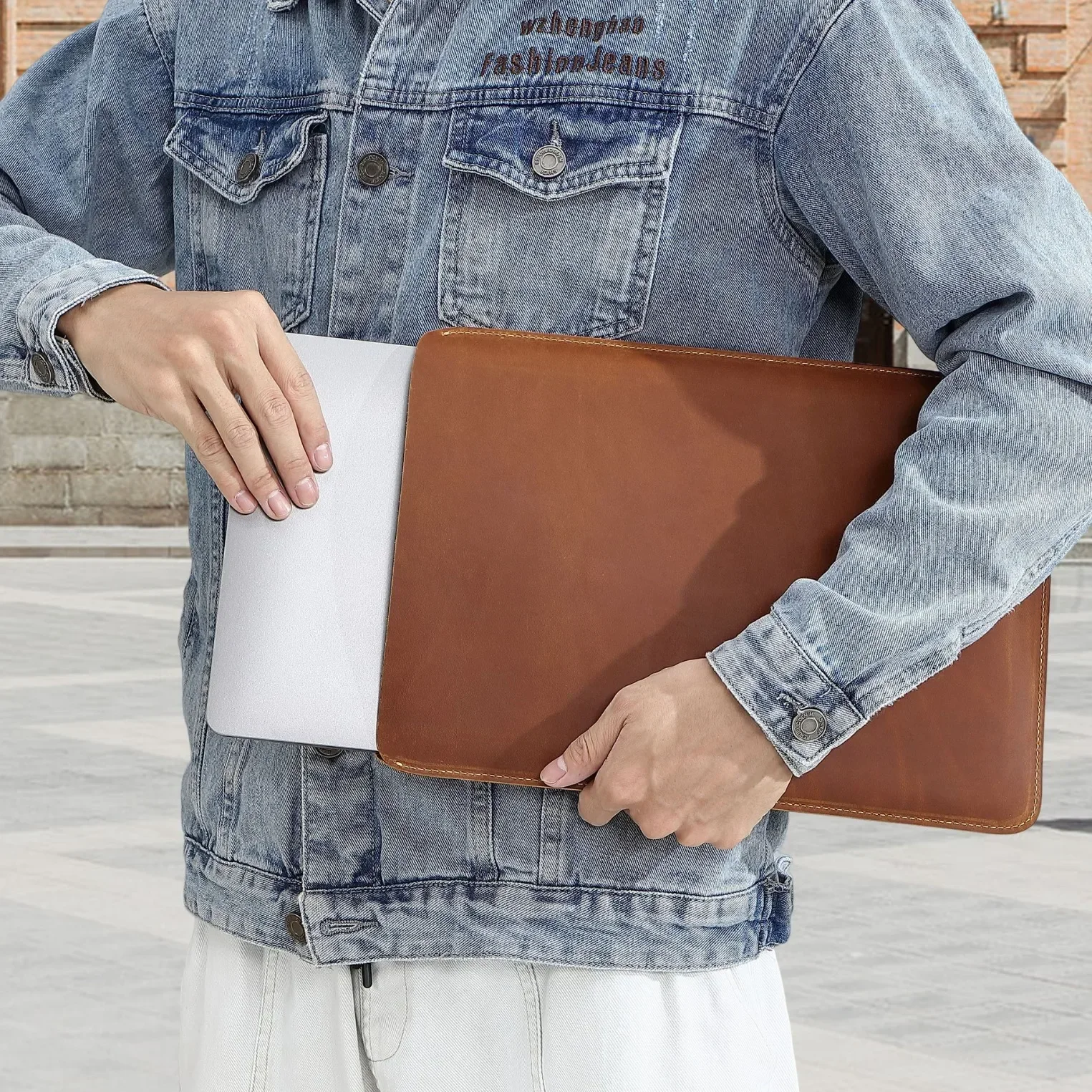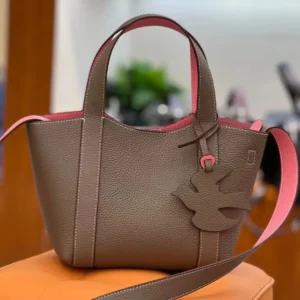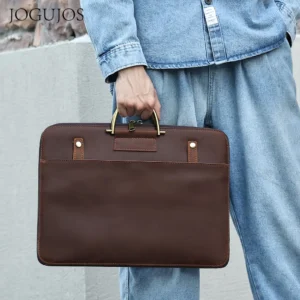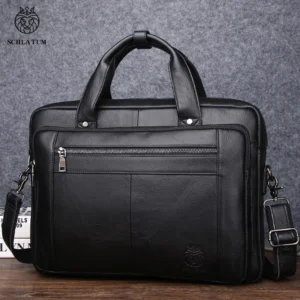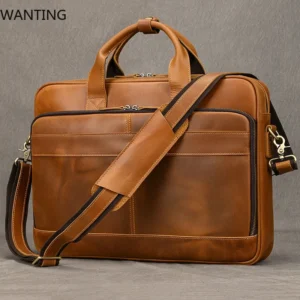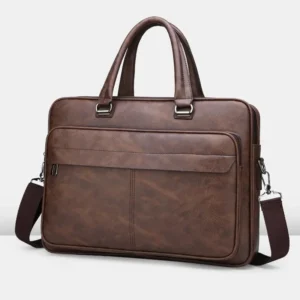Introduction: The Importance of Choosing the Right Briefcase Size
Finding the perfect briefcase size is much like choosing the right pair of shoes—when it fits well, you hardly notice it’s there, but when it doesn’t, the discomfort is impossible to ignore. The right dimensions aren’t just about aesthetics; they directly impact your daily comfort, organization, and professional image.
Many professionals have experienced the frustration of a briefcase that’s either too small (forcing difficult decisions about what to leave behind) or too large (becoming unnecessarily heavy and cumbersome to carry). These seemingly minor inconveniences can accumulate into daily frustration.
When considering what makes a briefcase size “best,” remember that the answer is highly personal and depends on:
– Your specific daily carrying needs
– Your physical build and comfort preferences
– Your professional environment and commute style
– The balance between capacity and portability you prefer
Throughout this guide, we’ll explore how to assess your needs and match them to the ideal briefcase dimensions. Understanding the fundamentals of timeless classic leather briefcases provides an excellent foundation for making the right sizing decision.
Assessing Your Carrying Needs: The Foundation of Sizing
Before considering inches and centimeters, start by taking inventory of what you carry daily. This practical approach ensures your briefcase serves your specific needs rather than forcing you to adapt to arbitrary dimensions.
Technology Devices:
– Laptop (including specific model and screen size)
– Tablet or e-reader
– Smartphone
– Chargers and cables
– Portable power bank
Documents and Papers:
– File folders
– Notebooks or planners
– Important documents
– Books or magazines
Work Accessories:
– Pens, highlighters, small office supplies
– Business cards
– Calculator or specialized tools
– Headphones
Personal Items:
– Keys
– Wallet
– Water bottle
– Snacks or lunch
– Glasses case
– Medication
Consider which items are “must-carries” (present every day) versus occasional items. This distinction helps determine your baseline size requirements while allowing flexibility for varying needs.
Creating your personalized inventory is the first critical step toward finding your ideal briefcase size. The definitive guide to ideal leather briefcases provides additional insights on how to match your carrying needs with the right briefcase features.
Understanding Standard Briefcase Dimensions
Briefcases typically fall into three size categories, each with fairly standard dimensional ranges. Understanding these categories provides a framework for your selection process:
Small/Compact Briefcases
– Width: 12-14 inches
– Height: 9-10 inches
– Depth: 2-3 inches
Medium/Standard Briefcases
– Width: 15-16 inches
– Height: 11-12 inches
– Depth: 3-5 inches
Large/Executive Briefcases
– Width: 17+ inches
– Height: 12-14 inches
– Depth: 5-7 inches
While laptop size often drives briefcase selection, depth is arguably the most critical yet overlooked dimension. A difference of just 2 inches in depth can dramatically change what fits inside, regardless of width and height.
When reviewing product specifications, pay attention to whether dimensions refer to external measurements (the outer shell) or internal capacity (actual usable space). The difference can be significant, especially with structured leather briefcases where wall thickness reduces interior space.
The difference between various sizes becomes clearer when comparing compact and spacious leather briefcases side by side, showing how dimensional changes impact practical usage.
Small Briefcases: Compact Efficiency (12-14 inches)
Small briefcases offer sleek efficiency for professionals who prioritize mobility and minimalism. With typical dimensions of 12-14 inches wide, 9-10 inches tall, and 2-3 inches deep, these compact carriers are designed for essentials.
Typical Capacity:
– Laptops up to 13 inches
– A thin document folder or slim notebook
– Essential accessories (phone, wallet, keys, pens)
– Minimal chargers and cables
Ideal For:
– Minimalist professionals
– Short commutes or walking-heavy routines
– Tablet-focused users
– Secondary briefcase for client meetings
Advantages:
– Lightweight and easy to carry
– Projects a sleek, modern professional image
– Easier to manage in crowded spaces
– Forces disciplined packing habits
– Less strain on shoulders and back
Limitations:
– Restricts carrying capacity
– Limited organization compartments
– May require tough choices about what to bring
– Little room for unexpected items or purchases
For professionals who prefer traveling light, our collection of slim leather briefcases offers compact options without sacrificing style or essential functionality.
Medium Briefcases: The Versatile Standard (15-16 inches)
Medium-sized briefcases represent the most popular and versatile option, striking a balance between capacity and portability. With dimensions typically spanning 15-16 inches wide, 11-12 inches tall, and 3-5 inches deep, they accommodate most professional needs without excessive bulk.
Typical Capacity:
– Laptops up to 15-16 inches
– Multiple document folders or a 1-inch binder
– Standard accessories (phone, wallet, keys, pens)
– Laptop charger and cables
– Small personal items (sunglasses, compact umbrella)
– Light lunch container or water bottle
Ideal For:
– Daily office commuters
– General business professionals
– Most laptop users
– Those needing moderate document capacity
Advantages:
– Versatile enough for most professional scenarios
– Balanced weight distribution when carried
– Sufficient organization without excessive compartmentalization
– Professional appearance suits most environments
– Accommodates unexpected items without appearing overstuffed
Potential Drawbacks:
– May feel too large for minimalists
– Could be insufficient for document-heavy professions
– Might appear too structured for creative industries
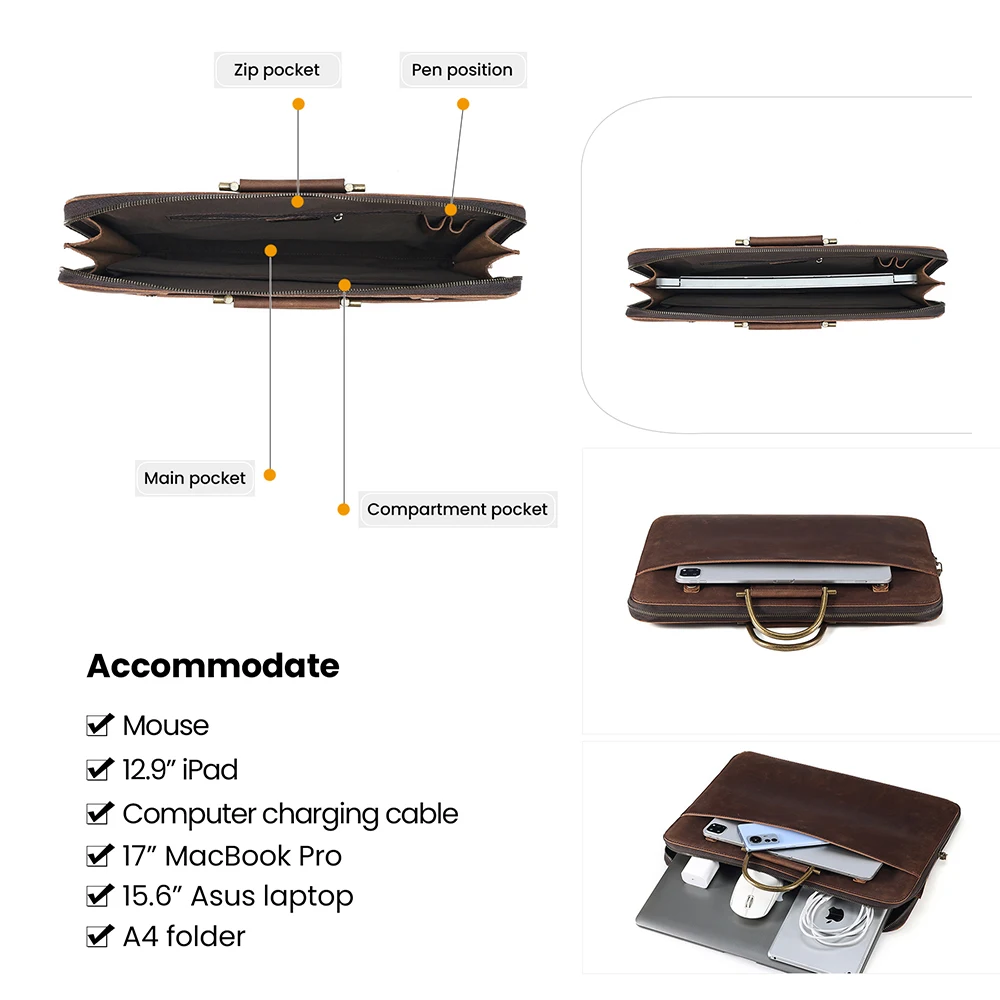
For a professional looking for this versatile standard size, exploring our classic laptop briefcase collection provides excellent options that balance capacity with professional aesthetics.
Large Briefcases: Maximum Capacity (17+ inches)
Large briefcases provide substantial carrying capacity for professionals with extensive daily needs. With dimensions of 17+ inches wide, 12-14 inches tall, and 5-7 inches deep, these substantial carriers offer room for everything from large laptops to extensive documentation.
Typical Capacity:
– Laptops up to 17 inches
– Multiple binders or document folders
– Full complement of accessories and chargers
– Tablet in addition to laptop
– Meal containers and water bottle
– Personal items (umbrella, light jacket)
– Small overnight essentials
Ideal For:
– Legal, financial, or consulting professionals
– Those who carry extensive documentation
– Professionals who travel frequently for single-night trips
– Individuals using larger laptops or multiple devices
– Those substituting a briefcase for both laptop bag and small overnight bag
Advantages:
– Ample storage eliminates tough choices about what to bring
– Multiple organization compartments for efficient sorting
– Can accommodate unexpected items or purchases
– Often includes specialized pockets for specific purposes
– Serves multiple functions (work, travel, meetings)
Limitations:
– Significantly heavier, especially when full
– More cumbersome in crowded environments
– May appear excessive in minimalist office cultures
– Can strain shoulders and back during longer carries
– Potential to overstuff due to available space
Professionals requiring maximum capacity while maintaining a refined appearance should consider our large leather work tote collection for spacious yet sophisticated options.
How Briefcase Depth Affects Usable Capacity
While width and height often get the most attention, depth is frequently the dimension that most dramatically impacts a briefcase’s practical capacity. A slim briefcase might have the same width and height as another model, yet hold significantly less due to restricted depth.
The difference between a 3-inch and 5-inch depth completely transforms functionality. A 3-inch depth typically allows for a laptop and slim items arranged in a single layer. In contrast, a 5-inch depth creates a three-dimensional space where items can be stacked or placed alongside each other—fitting a water bottle, lunch container, or bulkier accessories.
Briefcase construction also affects capacity:
– Single gusset designs maintain a slim profile but limit expansion
– Double gusset construction allows for some flexibility when fully loaded
– Expandable designs with additional zippered compartments provide versatility
The depth dimension also determines organizational possibilities. Deeper briefcases can incorporate multiple separated compartments, while slimmer designs typically feature a simpler layout. Knowing how to choose the perfect leather briefcase involves understanding how these dimensional aspects affect everyday use.
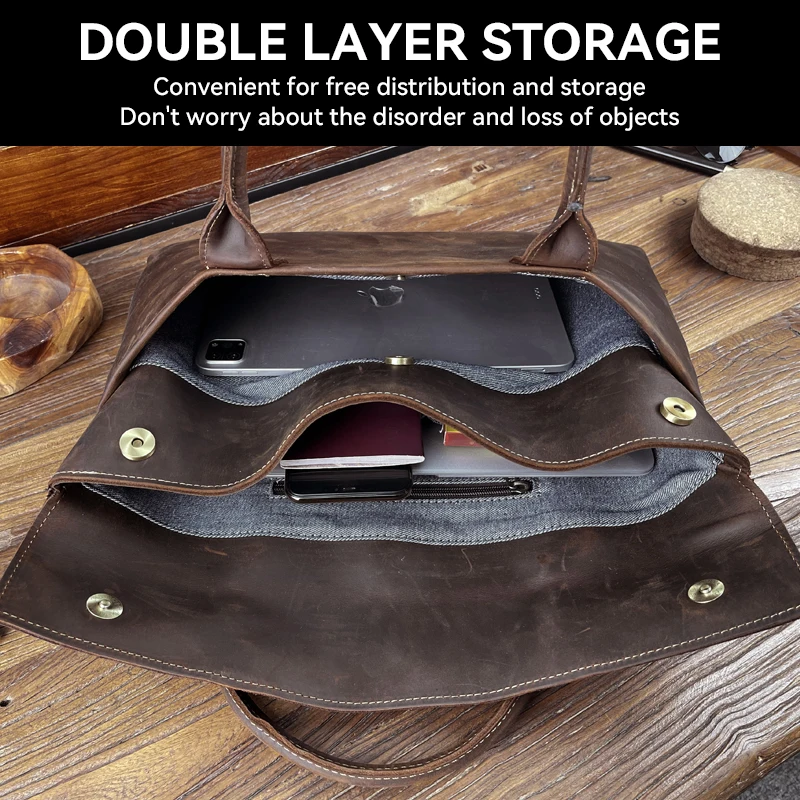
Matching Briefcase Size to Your Professional Lifestyle
Your professional demands and daily routine should heavily influence your briefcase size selection. Different careers and lifestyles create distinct carrying requirements:
Daily Office Commuter
The typical office professional who works primarily from one location benefits from a medium-sized briefcase (15-16 inches). This size accommodates a standard laptop, moderate documentation, and personal essentials while remaining manageable for daily transport. Public transit commuters might lean toward more compact options, while car commuters can consider slightly larger sizes.
Frequent Business Traveler
Those regularly traveling for work need a briefcase that balances capacity with mobility. A medium-large briefcase (16-17 inches) offers room for travel essentials while remaining carry-on compliant. Look for depths of 4-5 inches to accommodate chargers, adapters, and overnight items without requiring a separate bag.
Document-Intensive Professional
Legal, financial, and consulting professionals often carry substantial documentation. These careers typically benefit from larger briefcases (17+ inches) with depths of 5-7 inches to accommodate multiple folders, binders, and reference materials alongside technology.
Minimalist Executive
Senior executives often carry fewer items but require sophisticated presentation. A compact briefcase (13-14 inches) presents a refined image while accommodating essentials like a thin laptop, tablet, and minimal documentation—perfect for moving between meetings without bulk.
Understanding the strategic benefits of large capacity briefcases can be particularly valuable for professionals whose work demands extensive carrying capacity.
Finding the Perfect Balance: Capacity vs. Portability
The fundamental tension in briefcase sizing lies between carrying capacity and ease of transport. This balance varies based on individual priorities, physical capabilities, and professional requirements.
Consider that an empty medium briefcase typically weighs 2-4 pounds, while a large leather briefcase can weigh 4-6 pounds before adding any contents. Once filled, a large briefcase might exceed 15 pounds—a significant weight to carry regularly.
Weight distribution dramatically affects comfort. A well-designed briefcase distributes weight close to the body and provides balanced loading. Handle and strap quality become increasingly important as size increases.
Your body frame and height also influence what feels proportional and comfortable. A briefcase that hits at the right hip height for your build will feel more natural to carry. As a general guideline, the bottom of your briefcase should fall approximately at hip level when carried by the handles.
Many professionals benefit from the “80/20 approach”—choosing a size that comfortably accommodates your needs 80% of the time, rather than selecting based on maximum capacity scenarios that occur infrequently.
Comparing large and slim leather briefcase options reveals that finding the right balance depends on your specific professional demands and physical comfort preferences.
Men's Classic Leather Briefcase, Slim Leather Laptop Briefcase, Slim Leather Portfolio Briefcase
$93.67 Select options This product has multiple variants. The options may be chosen on the product pageBrown Leather Work Tote, Large Leather Work Tote
$194.38 Select options This product has multiple variants. The options may be chosen on the product pageClassic Laptop Briefcase, Men's Classic Leather Briefcase, Slim Leather Attache Case
Price range: $353.50 through $360.81 Select options This product has multiple variants. The options may be chosen on the product pageBlack Leather Briefcase, Classic Laptop Briefcase, Men's Classic Leather Briefcase, Slim Leather Laptop Briefcase
$228.72 Select options This product has multiple variants. The options may be chosen on the product pageBrown Leather Briefcase, Classic Laptop Briefcase, Crazy Horse Leather Satchel, Men's Classic Leather Briefcase
Price range: $172.15 through $200.02 Select options This product has multiple variants. The options may be chosen on the product pageMen's Slim Leather Briefcase, Slim Leather Laptop Briefcase, Vegan Leather Briefcase
Price range: $120.82 through $131.11 Select options This product has multiple variants. The options may be chosen on the product page
Proportional Aesthetics: How Size Affects Professional Appearance
Beyond practicality, a briefcase’s dimensions significantly impact your professional appearance. The visual harmony between your briefcase and your physical build contributes to an overall impression of put-together professionalism.
Generally, your briefcase should appear proportional to your body frame. Taller individuals (over 6 feet) can comfortably carry larger briefcases without them appearing oversized, while shorter professionals might find medium or compact briefcases create better visual balance.
Different industries also have subtle aesthetic expectations regarding briefcase sizing:
– Finance and law traditionally favor substantial briefcases that project stability and capacity
– Creative fields often embrace slimmer, more modern profiles
– Technology sectors typically welcome more contemporary, streamlined designs
Material and structure also influence perceived size. A soft leather briefcase appears less bulky than a rigid, structured case with the same dimensions. Dark colors typically create a more compact visual impression than lighter tones.
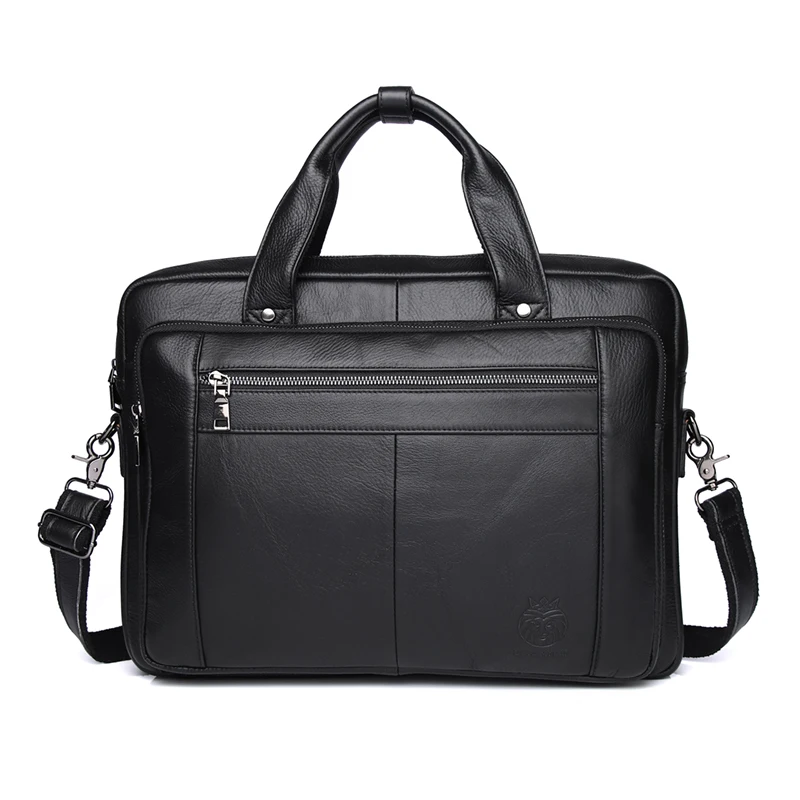
For those seeking a briefcase with balanced proportions that projects professionalism, our men’s slim leather briefcase collection offers options designed with visual harmony in mind.
How to Accurately Measure for Your Ideal Briefcase
Taking accurate measurements ensures your briefcase will accommodate your essential items comfortably. Follow these steps to determine your ideal dimensions:
Measure your laptop correctly
– Measure diagonally from corner to corner of the screen (not including the frame)
– Measure the closed laptop’s width, height, and depth
– Add 0.5-1 inch to each dimension for comfortable fitAccount for protective cases
– If you use a laptop sleeve or case, measure with it on
– Remember that rigid laptop cases add significant bulkArrange your essential items
– Place all must-carry items on a flat surface
– Arrange them as they would sit in your briefcase
– Measure the total footprint (width and height)
– Measure the height of stacked items for depth requirementsUnderstand measurement terminology
– “Fits up to X-inch laptop” typically refers to screen size, not actual laptop dimensions
– “Interior dimensions” tell you usable space
– “Exterior dimensions” include the briefcase structure itselfConsider access requirements
– Allow extra space for easily retrieving items
– Consider how items will be arranged (flat or stacked)
For laptop-specific guidance, our resource on finding the perfect leather bag for laptops provides detailed measurement techniques to ensure compatibility.
Frequently Asked Questions About Briefcase Sizing
What’s the best size for a 15.6-inch laptop?
For a 15.6-inch laptop, look for a briefcase with interior dimensions of at least 16-17 inches wide and 11-12 inches tall. This provides the half-inch buffer needed on each side. Medium briefcases (15-16 inches exterior width) typically accommodate these laptops comfortably.
Are briefcase sizes standardized across brands?
No, briefcase sizing isn’t strictly standardized. While general categories exist (small, medium, large), the exact dimensions can vary by several inches between manufacturers. Always check specific measurements rather than relying on size category names.
How much extra room should I allow beyond my laptop size?
Allow at least half an inch of extra space on all sides of your laptop for easy insertion and removal. For other items, consider an additional 1-2 inches of depth beyond your stacked items for comfortable access.
Can I fit a water bottle and lunch container in a standard briefcase?
Medium briefcases with 4-5 inches of depth typically accommodate a slim water bottle and compact lunch container. Large briefcases with 5+ inches of depth handle these items more comfortably. Compact briefcases (2-3 inches deep) generally can’t accommodate these items.
How do I know if a briefcase will comply with airline carry-on regulations?
Most standard and compact briefcases comply with airline personal item restrictions. For carry-on compliance, ensure exterior dimensions don’t exceed 22 x 14 x 9 inches, though specific airlines may have different requirements.
What’s the difference in sizing for hard-sided vs. soft-sided briefcases?
Hard-sided briefcases offer fixed capacity with no flexibility, so interior measurements are critical. Soft-sided briefcases provide some give, potentially accommodating slightly more than their stated dimensions, though overstuffing affects appearance and functionality.
For those specifically seeking laptop-optimized options, our slim leather laptop briefcase collection provides properly sized options for various laptop dimensions.
Common Mistakes to Avoid When Selecting Briefcase Size
Choosing for today only
Many buyers select a briefcase that perfectly fits their current items but leaves no room for variation. Your carrying needs will likely change—select a size that accommodates occasional extras or future device upgrades.Focusing exclusively on laptop fit
While laptop accommodation is important, don’t neglect your other daily items. A briefcase that fits your laptop perfectly but can’t handle your documents, accessories, or personal items will quickly prove frustrating.Overlooking depth dimension
Many buyers focus on width and height while ignoring depth. Yet depth often determines whether you can carry three-dimensional objects like chargers, water bottles, or stacked items. A difference of 2 inches in depth dramatically changes capacity.Choosing maximum capacity over daily comfort
Some professionals select the largest briefcase available “just in case,” but carrying unnecessary weight and bulk daily takes a toll. Choose based on your regular needs, not occasional maximum-capacity scenarios.Relying on general recommendations without personal assessment
No universal “best size” exists. Recommendations based on profession or laptop size provide starting points, but your specific items, commute, physical build, and preferences should guide your final decision.
When to Consider Custom Sizing for Your Briefcase
While standard briefcase sizes accommodate most professionals, certain situations might warrant exploring custom options:
Specialized Equipment Needs
Professionals who carry unusual equipment dimensions—specialized tablets, unique tools, or oversized laptops—may find standard sizes limiting. Custom dimensions ensure proper accommodation without excess bulk.
Specific Document Requirements
Those working with non-standard document sizes, architectural drawings, or specialized folios might benefit from customized dimensions that precisely fit these materials.
Physical Considerations
Individuals with specific ergonomic requirements due to height, build, or physical conditions may find custom-sized briefcases provide improved comfort and usability.
Frequent Specialized Travel
Those who regularly travel through specific security checkpoints or use particular transportation modes with strict dimensional requirements might benefit from a briefcase sized to those exact specifications.
When exploring custom options, look for manufacturers who:
– Provide detailed consultation about your specific needs
– Offer precise dimensional modifications rather than vague customization
– Have experience creating solutions for your particular profession or requirement
Conclusion: Finding Your Perfect Fit
The “best” briefcase size isn’t universal—it’s the one that aligns with your specific professional needs, physical comfort, and aesthetic preferences. By starting with a thoughtful assessment of what you carry and how you work, you can identify dimensions that enhance rather than hinder your daily routine.
Remember these key considerations:
– Your carrying needs form the foundation of your size requirements
– Standard size categories provide helpful starting points, not rigid rules
– The often-overlooked depth dimension dramatically impacts practical capacity
– The perfect balance between capacity and portability varies by individual
– Proportional aesthetics contribute to your professional presentation
Take the time to measure your essentials, consider your professional lifestyle, and evaluate how different sizes would integrate into your daily routine. This thoughtful approach ensures you’ll select a briefcase that serves as a reliable partner rather than a daily frustration.
A quality briefcase represents a significant investment in your professional life—sizing it correctly transforms it from a mere accessory into an invaluable tool that enhances your efficiency and presentation every day.

